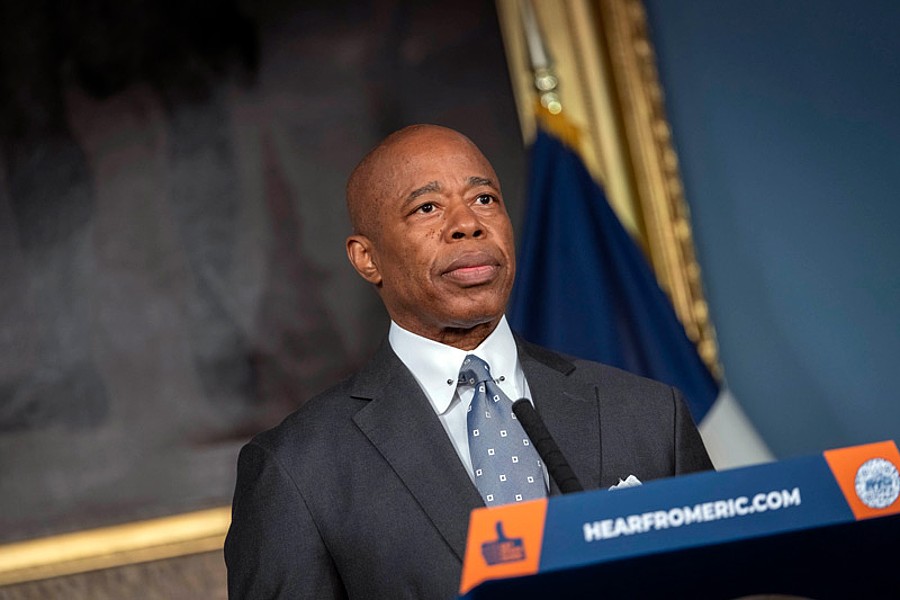
New York City Mayor Eric Adams today released a new study — commissioned by New York City and conducted in cooperation with Mastercard — exploring how sidewalk sheds and scaffolding negatively impact Manhattan businesses.
Evaluating aggregated and anonymized spending averages from Mastercard, the study shows that cardholders spend between $3,900 and $9,500 less each month at businesses located in buildings with sidewalk sheds. Restaurants and bars are most impacted, reporting a 3.5 percent to 9.7 percent decrease in weekly transactions in the six months following shed construction.
Last year, the Adams administration released its “Get Sheds Down” plan, a wide-ranging series of nine initiatives aimed at compelling building owners to make needed repairs quickly so unsightly sidewalk sheds and scaffolding do not languish in place for years, reducing the number of unnecessary long-standing sidewalk sheds in New York City and improving the design of necessary sheds and scaffolding so they’re no longer a blight to the community.
“Too many businesses throughout New York City have been shrouded by hundreds of miles of sidewalk sheds and scaffolding, some of which have been up for decades,” said Mayor Adams. “Those sheds may have gone up to keep people safe, but they’re still up because it’s cheaper for building owners to leave them up than to fix their buildings. That’s bad for public safety, bad for our city, and, as this study shows us, bad for business, too. We’ve already taken 173 miles of sheds down in the past year, and the package of bills we’re working on with the City Council will allow us to flip the script so repairs get finished, sheds come down, and storefronts can shine again.”
“If left up too long, scaffolding is dank, dark, and, now for the first time, we know in a dollars-and-cents way, depressing for businesses’ bottom lines,” said Deputy Mayor for Operations Meera Joshi. “Scaffolding is critical for safety, but when it is used instead as a Band-Aid, it becomes enemy number one for a city otherwise growing more vibrant by the day. With Mayor Adams’ ‘Get Sheds Down’ plan, we are attacking longstanding scaffolding on all fronts: enforcement, design, and refining our building inspection cycle.”
“New York City has done remarkable work recovering from COVID-19, but full recovery requires elimination of unnecessary burdens to businesses, such as sidewalk sheds that hamper sales at brick-and-mortar stores and make it harder for landlords to tenant their spaces,” said Deputy Mayor for Housing, Economic Development, and Workforce Maria Torres-Springer. “We look forward to continuing our tireless work supporting small businesses while improving the public realm.”
“I think most New Yorkers intuitively knew that a gloomy sidewalk shed has a negative impact on storefront businesses, but, thanks to this study, we now have data to back that up, in plain dollars and cents,” said New York City Department of Buildings (DOB) Commissioner Jimmy Oddo. “Sidewalk sheds are an important safety tool to protect the public from unsafe building conditions, but when building owners leave them up for years on end while repairs languish, it robs New Yorkers of vibrant streetscapes and takes money out of the pockets of small business owners. This study makes it clear that we need stronger enforcement tools in place to compel owners to get their building repairs done faster, so that these sheds stay up only as long as necessary and don’t needlessly depress our commercial corridors. The department is partnering with the City Council to advance legislation that would tighten regulations on sheds, which, when combined with our ongoing efforts to reimagine pedestrian protection design, will help not just improve the look of our city, but will be a boon to the city’s economic vitality.”
“Mayor Adams said it best while establishing Executive Order 2: small businesses are critical to the city’s economy,” said New York City Department of Small Business Services Acting Commissioner Dynishal Gross. “‘Get Sheds Down’ balances public safety and small business success by incentivizing less obstructive building safety measures and requiring prompt building repairs. The initiative will free New York City storefronts and sidewalks from the confines of yearslong scaffolding and ensure a more vibrant public realm for generations to come.”
- French Heritage Society Fêtes Reopening Of Notre-Dame Cathedral At “Celestial Ball” In New York
- How Debris In A Construction Site can Cause Accidents. What You Can Do
- Harlem’s Diddy’s Mansion Gets Discounted Bid Amid Legal Storm
- District Council 9 Launches Recruitment for Aspiring Metal Refinisher Apprentices!
- Mayor Adams Unveils November Financial Plan: Investing In Safety And Affordability!
“This study quantifies what all New Yorkers know intuitively: sidewalk sheds kept up for too long negatively impacts storefronts under their shadow,” said Chief Public Realm Officer Ya-Ting Liu. “When we ‘Get Sheds Down’ faster, we not only improve the public realm, but help businesses with their bottom line. I look forward to working with the City Council and DOB to pass a package of bills that will do just that.”
“Supporting the ‘Get Sheds Down’ plan is vital for nightlife and hospitality businesses across New York City,” said New York City Office of Nightlife Executive Director Jeffrey Garcia. “Scaffolding that remains up unnecessarily for extended periods of time results in a significant decrease in profits, especially for bars and restaurants. It can also prohibit them from participating in the city’s new ‘Dining Out NYC’ program, which allows for sidewalk and roadway seating. By addressing this issue, we can help these businesses thrive, enhance the beauty and safety of our streets, and contribute to a more vibrant city for everyone.”
“The data shows what New Yorkers already know firsthand — long-standing sidewalk sheds negatively impact the economy and livability of this city,” said “New” New York Executive Director B.J. Jones. “That’s why it is so important to create better designs and more robust enforcement tools to get facades repaired, sheds down, and sidewalks returned to our pedestrians and small businesses.”
The Adams administration is partnering with the City Council on proposals that would allow for a wider variety of colors for sidewalk sheds and scaffolding, increase lighting requirements for sheds, reduce the duration of sidewalk shed permits, and introduce new penalties if building repairs are not performed in a timely manner.
Earlier this summer, DOB launched a comprehensive review of the city’s Façade Inspection and Safety Program, colloquially known as “Local Law 11” inspections, in partnership with international engineering consulting firm Thornton Tomasetti. Local Law 11 requires building owners to hire private inspectors to perform façade maintenance inspections, with a rigid one-size-fits-all set of regulations for all buildings over six stories tall. While the current regulations compel owners to inspect and mitigate any found buildings hazard with sheds or other protection, it doesn’t do enough to encourage repairs — resulting in sheds standing in place for years with no progress on the repairs. Recommendations from the administration will consider regulatory changes that could reduce sidewalk sheds and scaffolding that are not protecting the public.
This study of Local Law 11 is a part of the administration’s Get Sheds Down plan. As part of the multifaceted plan, the city is working with design firms to reimagine pedestrian safety infrastructure expected to be delivered in 2025, released technical guidance to help the industry understand when they can use safety netting in place of sidewalk sheds, launched a permanent program allowing art on sidewalk sheds, stepped up criminal court cases against the worst offenders who refuse to make needed building repairs, and increased DOB oversight over expired sidewalk shed permits.
Since Mayor Adams launched the Get Sheds Down plan, 173 miles of existing sidewalk sheds have come down from New York City sidewalks. Critically, since the plan was announced, the city has removed 259 long-standing sheds (sheds that have been up for over five years) from the streets, and also removed the longest-standing permitted shed in the city, which had been an eyesore in Harlem for over 21 years.
“The sidewalks of our city should be safe, clean, and welcoming,” said New York State Senator Brad Hoylman-Sigal. “Unfortunately, scaffolding and sidewalk sheds have made some of our sidewalks places New Yorkers choose to steer clear of and that is now affecting our small businesses. The study released today shows that businesses in Manhattan with sidewalk sheds lose somewhere between $4000 and $9500 every single month, with restaurants and bars suffering the greatest losses. It’s clear that it’s time to do as Mayor Adams says and ‘Get Sheds Down’ so that our pedestrians and small businesses can enjoy all that our city has to offer without unsightly obstacles in their way.”
“New York City is now home to more than 9,000 sidewalk sheds collectively stretching over 400 miles — greater than the length of the Grand Canyon,” said New York State Assemblymember Jenifer Rajkumar. “We have long known that unsightly sheds hurt businesses, and our historic study reveals the exact price tag: up to $9,500 less spending per month by cardholders, and a 9.7 percent decrease in bar and restaurant spending. For small businesses, many immigrant-owned, that revenue loss could be the difference between staying open or closing for good. This lays clear the imperative to implement our ‘Get Sheds Down’ plan to reimagine shed design and speed up repairs without compromising safety. Making sheds aesthetically pleasing and short-lived will unlock the beauty of our blocks while removing spots for bad apples to congregate. That translates to increased foot traffic, uplifting street-level businesses and generating millions in economic activity.”
“Sidewalk sheds that are up for long periods of time don’t just negatively impact neighborhood quality of life — there’s also a significant financial consequence,” said Manhattan Borough President Mark Levine. “These numbers show that sheds that linger hurt our local economy and small businesses. We need to do better to ensure that facade repairs are done quickly. Small businesses can’t afford to keep losing thousands of dollars each month.”
“For our small businesses, getting buried underneath sidewalk sheds for years can mean they lose out on local foot traffic and thousands of dollars in business,” said New York City Councilmember Keith Powers. “The local businesses that make our neighborhoods great operate on razor-thin margins, and a decrease in business for even a few months can be make-or-break for their livelihoods. I’m proud to be leading the charge in the Council on scaffolding reform and to partner with the administration to get sheds down and support our storefronts.”
“Sidewalk sheds and scaffolding are meant to keep New Yorkers safe, but too often sheds are left in place longer than they need to be, creating quality of life, public safety, and economic concerns,” said New York City Councilmember Carlina Rivera. “By changing rules to expedite repairs and giving artists the opportunity to display works on sidewalk sheds, City Council and the mayoral administration are working together to ‘Get Sheds Down’ and reduce their negative impact on neighborhoods.”
“We are delighted to announce progress on removal of almost half the linear feet of sidewalk sheds in our district, thanks in part to work by the mayor and his staff on this issue,” said Dan Biederman, president, 34th Street Partnership.”
Photo credit: NYC.gov
Become a Harlem Insider!
By submitting this form, you are consenting to receive marketing emails from: . You can revoke your consent to receive emails at any time by using the SafeUnsubscribe® link, found at the bottom of every email. Emails are serviced by Constant Contact








